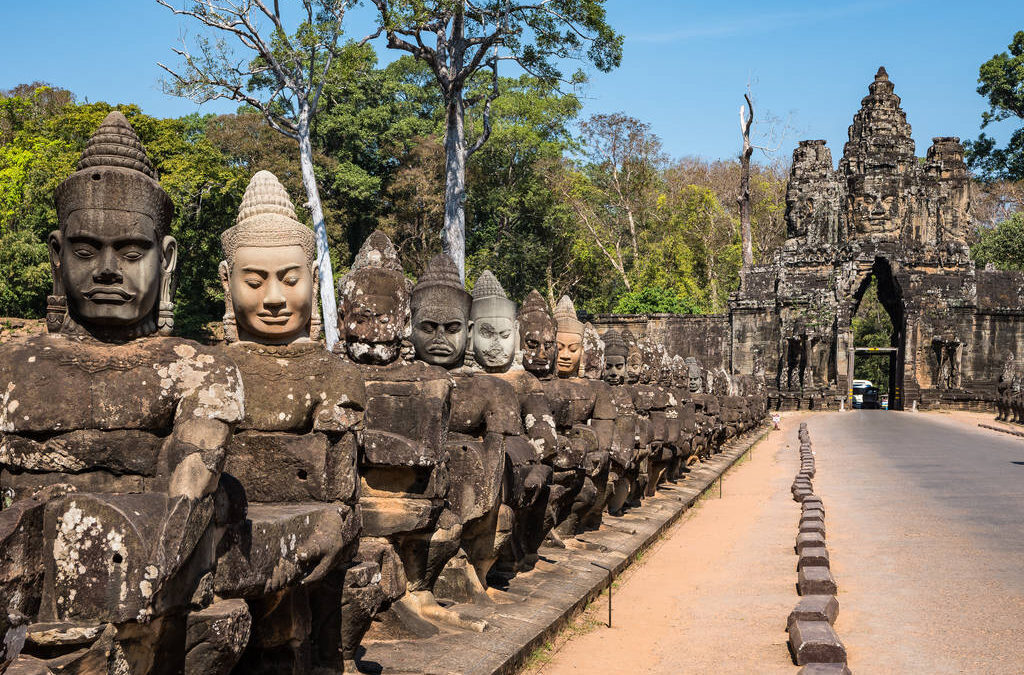While both are stunning Khmer monuments, you'll find they serve very different purposes! Angkor Thom is a massive 9-square-kilometer walled city built by King Jayavarman VII, featuring the enigmatic Bayon Temple with its famous face-towers. In contrast, Angkor Wat is a single temple complex commissioned by King Suryavarman II, dedicated initially to Vishnu. The structures also differ in their religious focus – Angkor Thom accepts Buddhism, while Angkor Wat began as Hindu. There's so much more to uncover about these architectural marvels!
Key Takeaways
- Angkor Thom is a complete walled city spanning 3 kilometers, while Angkor Wat is a singular temple complex.
- Angkor Thom was built as a Buddhist sanctuary, whereas Angkor Wat was originally constructed as a Hindu temple.
- Angkor Thom's Bayon Temple features iconic face towers, contrasting with Angkor Wat's five peaks representing Mount Meru.
- Angkor Thom was commissioned by King Jayavarman VII, while Angkor Wat was built earlier by King Suryavarman II.
- Angkor Thom follows a square mandala layout representing the universe, while Angkor Wat uses a rectangular design with concentric galleries.
Historical Origins and Royal Patrons
The grandeur of ancient Khmer architecture emerges through two remarkable monuments built just decades apart.
You'll find that the construction timeline reveals two distinct periods of ambitious royal vision. Angkor Wat's story begins in 1122 CE when King Suryavarman II commissioned what would become one of humanity's most impressive temples.
Less than a century later, King Jayavarman VII would establish Angkor Thom as the empire's new capital, following his triumphant restoration after the Cham invasion of 1177.
The king contributions couldn't be more different – while Suryavarman II created Angkor Wat as a Hindu temple dedicated to Vishnu, Jayavarman VII's Buddhist faith shaped Angkor Thom's identity.
The religious visions of two Khmer kings birthed distinct architectural marvels – one Hindu, one Buddhist – in ancient Angkor.
You can still see these contrasting influences today, though Angkor Wat later adopted Buddhism while remaining continuously occupied – unlike Angkor Thom, which was abandoned before 1609.
Sacred Architecture and Design Philosophy
Sacred geometry and mystical symbolism merge beautifully in these architectural marvels, setting them distinctly apart in both form and function.
You'll notice that Angkor Wat's five towering peaks mirror Mt. Meru's sacred mountain ranges, while Angkor Thom's entire layout forms a perfect mandala – that's sacred geometry at its finest!
When you investigate these sites, you'll see how architectural symbolism plays out differently in each.
Angkor Wat's rectangular moat represents the cosmic ocean surrounding Mt. Meru, and it's perfectly aligned with the sun and moon.
Meanwhile, in Angkor Thom, you're walking through a complete 3-kilometer squared city that's literally designed as the universe itself.
The contrast is striking – Angkor Thom's famous Bayon Temple features mysterious faces everywhere you look, while Angkor Wat maintains a more austere presence.
Religious Symbolism and Cultural Impact
While Angkor Thom's religious symbolism might seem straightforward at initial glance, you'll uncover it's actually a fascinating fusion of Buddhist and Hindu traditions!
You'll be amazed by how King Jayavarman VII masterfully wove together Buddhist syncretism with traditional Hindu narratives throughout the complex.
At the Bayon temple, you can spot intricate carvings depicting the famous "Churning of the Ocean of Milk" alongside serene Buddhist imagery. The massive stone faces you'll encounter aren't just architectural showpieces – they represent either divine kingship or the compassionate bodhisattva Avalokiteshvara!
What's really incredible is how this religious blend influenced Southeast Asian culture.
The bas-reliefs don't just tell religious stories; they're actually preserving daily life scenes from the Khmer Empire, giving you a unique window into ancient Cambodia's vibrant past.
Unique Structural Features and Layout
Beyond the spiritual symbolism that defines these temples, you'll find that Angkor Thom's physical structure is nothing short of an engineering marvel! You're looking at a massive square city with 3-kilometer walls on each side and an impressive height of 8 meters. The layout design features five majestic entry towers, each crowned with four faces of Avalokiteshvara.
| Feature | Angkor Thom's Structural Innovations | Purpose |
|---|---|---|
| Moat | 3km on each side | Defense & stability |
| Entry Towers | Five gates with face carvings | Divine protection |
| Grid System | Cardinal direction alignment | Universe symbolism |
| Central Temple | Bayon at city's heart | Heaven-earth connection |
What's truly fascinating is how the ancient builders used locally sourced laterite for the walls – talk about smart construction! The entire city follows a precise grid system that'll make modern urban planners jealous.
Preservation Status and Current Condition
Thanks to significant international support and dedicated conservation efforts, you'll find Angkor Thom in a remarkable state of preservation today!
Angkor Thom stands magnificently preserved, a testament to global cooperation and unwavering dedication to protecting our world's ancient treasures.
The APSARA National Authority and UNESCO are working tirelessly to keep this ancient city standing strong, with groundbreaking restoration techniques being developed specifically for the site.
You'll notice ongoing projects everywhere you look – from the impressive 25-meter laterite wall restoration to the careful preservation work at the famous Bayon Temple.
While preservation challenges like urban expansion and environmental pressures keep conservationists on their toes, they're meeting these obstacles head-on!
Japanese experts have committed to a 30-year conservation project, and local Cambodian experts are gaining valuable restoration skills.
It's a delicate balance between protecting the site and welcoming the thousands of visitors who investigate its wonders each month.
Moats, Gateways, and Defensive Elements
Three incredible defensive features make Angkor Thom one of history's most formidable ancient cities!
You'll be amazed by its massive 100-meter-wide moat significance – once filled with crocodiles, it wasn't just for show. This cosmic ocean representation surrounded the entire city, protecting its inhabitants while symbolizing the waters around Mount Meru.
You won't believe the gateway symbolism at each of the five entrances! Each 23-meter-high gate features four giant faces of Avalokiteshvara, while 54 gods battle 54 demons along the sides.
The city's 8-meter-high laterite walls stretch an impressive 3 kilometers on each side, topped with a parapet for extra defense. When combined with the moat, these walls made Angkor Thom practically impenetrable – talk about ancient engineering at its finest!
Artistic Elements and Decorative Styles
While both monuments showcase incredible artistry, you'll notice striking differences in their decorative styles and artistic elements!
At Angkor Wat, you're immersed in mainly Hindu artistic motifs, with intricate bas-reliefs telling epic stories from the Ramayana and Mahabharata. The detailed carvings of celestial dancers and floral patterns will take your breath away!
Angkor Thom offers a completely different artistic experience.
You'll be mesmerized by the iconic faces of Avalokiteshvara at the Bayon temple – something you won't find at Angkor Wat. The decorative carvings here blend Hindu and Buddhist symbolism, reflecting a fascinating religious change.
While Angkor Wat's art follows a more narrative approach with its classical style, Angkor Thom accepts the unique Bayon style, featuring more symbolic and cosmic representations that'll make you feel like you're walking through the universe itself!
Conclusion
You'll find that while Angkor Wat and Angkor Thom are often confused, they're distinctly different sites. Angkor Wat is a single temple complex dedicated to Vishnu, while Angkor Thom's a massive walled city containing multiple temples, with the Bayon at its heart. They've got different purposes too – Angkor Wat's a temple-mountain, while Angkor Thom served as a complete urban center. Each tells its own fascinating story of Cambodia's rich architectural and cultural heritage!



